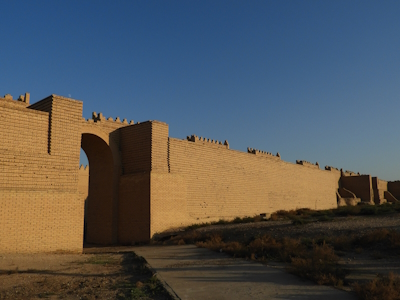Babylon

Babylon is the archaeological site of what once was one of the largest and oldest urban settlements in Mesopotamia.
It comprises the – largely unexcavated - remains of the ancient Neo-Babylonian capital, its city walls and temples. Particularly during the reign of Nebuchadnezzar II (604–561 BCE), monumental buildings such as the Etemenanki ziggurat and the Ishtar Gate were added. Babylon also had a lasting impact on global culture because of its 'exotic' Hanging Gardens and the Tower of Babel.
Community Perspective: Wojciech visited in 2021 and left with mixed feelings.
Map of Babylon
Community Reviews
Wojciech Fedoruk

Babylon is the ruin of the capital of the kingdom of Babylon, a country that had enjoyed its heyday since the time of Hammurabi (18th century B.C.E.). The golden age of the development of the city of Babylon fell during the time of King Nebuchadnezzar II, who ruled from 605 to 562 B.C.E. and significantly expanded Babylon, including building the magnificent Southern Palace.
After paying 25 thousand dinars I got a guide who showed me around the complex. The guide was incredibly nice, but his English was rather poor and he had a hard time explaining the historical or architectural complexities. Despite everything, he tried and told a lot, and what I heard was not necessarily pleasant to Polish ears. He worked here during the occupation of these areas by the allied forces (do you remember "Camp Babylon"?) and he cannot say anything good about this occupation. According to him, soldiers did not respect the monuments, treated them carelessly, and even deliberately devastated or took some artifacts - unfortunately, independent sources confirm what he said. On the other hand, he spoke positively about the Polish soldiers who gave him food and healed his seriously ill daughter at a time when it was extremely difficult to find a normal doctor. Apart from the purposefulness of the war itself, I do not understand why the main military camp of the occupiers had to be located next to a place of such great historical importance. Fortunately, Camp Babylon lasted "only" less than two years, and was relocated to less controversial sites in late 2004.
I have mixed feelings about the complex itself - despite being aware of the importance of Babylon as a historical site, I believe the reconstruction has gone too far here. The fact is that some of the relics were taken outside Iraq - for example, the original Ishtar Gate is on display at the Pergamon Museum in Berlin. Babylon was the apple of Saddam Hussein's eye, who, despite the historical integrity of the place, commissioned the reconstruction of most palaces - in general, you can see with the naked eye that the original walls account for about 5-10% of the total. Saddam put his initials on most of the bricks that were added. Fortunately, you can find places that were certainly original, including the relief-covered walls of the passage that ended at the Ishtar Gate. The reliefs depict Mušḫuššu - one of the main deities of Babylon - a creature with a serpent's head, a fish's body, two eagle legs, two more lion, a serpent's tail and a scorpion's venom spike.
Regarding Saddam, the dictator was so fond of Babylon that he placed one of his palaces on a nearby hill, clearly visible from the ancient city itself. The palace is abandoned today, but it can be visited, which I did not take advantage of, because that day I had a long way to go.
Babylon is one of the most popular tourist destinations in Iraq, one of the few that can be visited without the help of a tourist office. It is about an hour and a half from Baghdad, you can talk to taxi drivers who will take you there for $ 100. I paid $ 300 for an 800km trip to Babylon and Ur (WHS Ahwar of Southern Iraq), back to Baghdad on the same day.
Community Rating
Site Info
- Full Name
- Babylon
- Unesco ID
- 278
- Country
- Iraq
- Inscribed
- 2019
- Type
- Cultural
- Criteria
-
3 6
- Categories
- Archaeological site - Near Eastern
- Link
- By ID
Site History
2019 Inscribed
2016 Incomplete - not examined
1983 Deferred
Deferred as conditions under which recommendation made not yet fulfilled
Site Links
Unesco Website
In the News
Connections
The site has 38 connections
Art and Architecture
Constructions
Damaged
History
Individual People
Religion and Belief
Science and Technology
Timeline
Trivia
WHS on Other Lists
World Heritage Process
Visitors
38 Community Members have visited.
The Plaque
No plaque has been identified yet for this site.